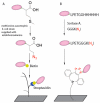Current Conjugation Methods for Immunosensors
- PMID: 29701654
- PMCID: PMC5977292
- DOI: 10.3390/nano8050278
Current Conjugation Methods for Immunosensors
Abstract
Recent advances in the development of immunosensors using polymeric nanomaterials and nanoparticles have enabled a wide range of new functions and applications in diagnostic and prognostic research. One fundamental challenge that all immunosensors must overcome is to provide the specificity of target molecular recognition by immobilizing antibodies, antibody fragments, and/or other peptides or oligonucleotide molecules that are capable of antigen recognition on a compact device surface. This review presents progress in the application of immobilization strategies including the classical adsorption process, affinity attachment, random cross-linking and specific covalent linking. The choice of immobilization methods and its impact on biosensor performance in terms of capture molecule loading, orientation, stability and capture efficiency are also discussed in this review.
Keywords: immobilization methods; immunosensors; polymeric nanomaterials.
Conflict of interest statement
The authors declare no conflict of interest.
Figures





References
-
- Heineman W.R., Jensen W.B. Leland C. Clark Jr. (1918–2005) Biosens. Bioelectron. 2006;21:1403–1404. doi: 10.1016/j.bios.2005.12.005. - DOI
Publication types
LinkOut - more resources
Full Text Sources
Other Literature Sources

